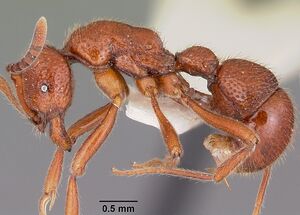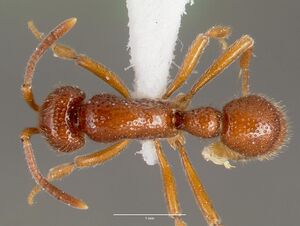Proceratium avium
| Proceratium avium | |
|---|---|

| |
| Scientific classification | |
| Kingdom: | Animalia |
| Phylum: | Arthropoda |
| Class: | Insecta |
| Order: | Hymenoptera |
| Family: | Formicidae |
| Subfamily: | Proceratiinae |
| Tribe: | Proceratiini |
| Genus: | Proceratium |
| Species: | P. avium |
| Binomial name | |
| Proceratium avium Brown, 1974 | |
| Synonyms | |
| |
A forest species endemic to Mauritius.
Identification
A member of the avium group in the stictum clade. Differs from all the members of the stictum clade by the body largely shining and regularly foveolate and sharing similar slender legs with the avium group species Proceratium diplopyx.
Keys including this Species
Distribution
Latitudinal Distribution Pattern
Latitudinal Range: -20.195° to -20.20000076°.
| North Temperate |
North Subtropical |
Tropical | South Subtropical |
South Temperate |
- Source: AntMaps
Distribution based on Regional Taxon Lists
Malagasy Region: Mauritius (type locality).
Distribution based on AntMaps
Distribution based on AntWeb specimens
Check data from AntWeb
Countries Occupied
| Number of countries occupied by this species based on AntWiki Regional Taxon Lists. In general, fewer countries occupied indicates a narrower range, while more countries indicates a more widespread species. |

|
Estimated Abundance
| Relative abundance based on number of AntMaps records per species (this species within the purple bar). Fewer records (to the left) indicates a less abundant/encountered species while more records (to the right) indicates more abundant/encountered species. |

|
Biology
Fisher (2005) - During a trip to Le Pouce on May 25 and 30, seven new collections of Proceratium from Le Pouce were recorded. Because of the small size of the forest patch, only two complete colonies were collected. For the other colonies we encountered, only a few foragers were removed. As Brown (1974) observed, foragers were returning to nests with what appeared to be spider eggs. In this case, they carried the eggs in the mandible, and did not support the eggs with the recurved gaster (Brown 1980). Baroni and de Andrade (2003) suggest the recurved gaster serves a phragmotic function, but I did not observe the recurved gaster being used to plug up the ant nest entrance.
Colony (BLF12137) included 352 workers, one ergatoid queen, and no males. Based on the colony size data reported in Baroni and de Andrade (2003), this is the largest colony size recorded for Proceratium. Collections in May by Brown in 1969 included males. All nests encountered were located in Nuxia verticillata Lamark (Loganiaceae), with entrances about 1.5-2 m above ground. This tree was also the preferred nesting site for Pristomyrmex bispinosus. This tree, called bois maigre in Mauritius, has gnarled and twisted trunks. It is endemic to Mauritius and Reunion and appears to be the sole nexsing site for Pristomyrmex bispinosus and Proceratium avium. The high winds that are common on Le Pouce abrade the twisted and intertwined trunks and branches. This action damages the tree at the contact point between intersecting branches and leads to the creation of a rot pocket and nesting site.
Three collections of Proceratium avium (BLF12011, 12014, and 12139) were foragers following Pristomyrmex bispinosus. These two species are very similar in color and general appearance. Brown in 1969 also observed this behavior. It is unclear why Proceratium is interspersed among the foraging workers of P. bispinosus. Conservation of either of these species should include further investigation of potential beneficial interactions between the species.
Castes
Worker
Images from AntWeb
   
| |
| Worker. Specimen code casent0101676. Photographer April Nobile, uploaded by California Academy of Sciences. | Owned by MHNG, Geneva, Switzerland. |
   
| |
| Paratype of Proceratium avium. Worker. Specimen code casent0102214. Photographer April Nobile, uploaded by California Academy of Sciences. | Owned by NHMUK, London, UK. |
   
| |
| Worker. Specimen code mcztype35017. Photographer April Nobile, uploaded by California Academy of Sciences. | Owned by MCZ, Cambridge, MA, USA. |
   
| |
| Paratype of Proceratium avium. Worker. Specimen code casent0003316. Photographer April Nobile, uploaded by California Academy of Sciences. | Owned by MCZ, Cambridge, MA, USA. |
    
| |
| Worker. Specimen code casent0059014. Photographer April Nobile, uploaded by California Academy of Sciences. | Owned by CAS, San Francisco, CA, USA. |

| |
| Holotype of Proceratium avium. Worker. Specimen code mcztype32216. Photographer April Nobile, uploaded by California Academy of Sciences. | Owned by MCZ, Cambridge, MA, USA. |
Male
Images from AntWeb
   
| |
| Paratype of Proceratium avium. Male (alate). Specimen code casent0003315. Photographer April Nobile, uploaded by California Academy of Sciences. | Owned by MCZ, Cambridge, MA, USA. |
Nomenclature
The following information is derived from Barry Bolton's Online Catalogue of the Ants of the World.
- avium. Proceratium avium Brown, 1974a: 72, figs. 1, 2 (w.q.m.) MAURITIUS.
- Type-material: holotype worker, 38+ paratype workers (total not stated), 1 paratype queen, 1 paratype male.
- Type-locality: holotype Mauritius: Le Pouce Mt, 700-800 m., 1.iv.1969, unnumbered colony, native forest (W.L. Brown); paratypes: 19+ workers, queen, male with same data, workers with same data but colony no. ICA-69, 30.iii.1969 (W.L. Brown), workers with same data but colony no. M-252 (W.L. Brown).
- Type-depositories: MCZC (holotype); ANIC, BMNH, CUIC, MCZC, NHMB (paratypes).
- Status as species: Bolton, 1995b: 366; Baroni Urbani & De Andrade, 2003b: 75 (redescription); Fisher, 2005: 661.
- Senior synonym of avioide: Fisher, 2005: 661.
- Distribution: Mauritius.
- avioide. Proceratium avioide De Andrade, in Baroni Urbani & De Andrade, 2003b: 78, figs. 37, 38 (w.q.m.) MAURITIUS.
- Type-material: holotype worker, 14 paratype workers, 1 paratype queen, 1 paratype male.
- Type-locality: holotype Mauritius: Le Pouce Mt, 700-800 m., 30.iii.1969, ICA-69, native forest (W.L. Brown); paratypes with same data.
- Type-depositories: MCZC (holotype); MCZC, LACM (paratypes).
- Junior synonym of avium: Fisher, 2005: 662.
Type Material
- Paratype, 3 workers, Le Pouce Mt., Mauritius, Brown,W.L., ANIC32-017661, Australian National Insect Collection.
Unless otherwise noted the text for the remainder of this section is reported from the publication that includes the original description.
Description
Worker
Baroni Urbani and de Andrade (2003) - Head longer than broad, with subparallel or gently convex sides. Vertex gently convex or straight in full face view. Clypeus broad, convex, protruding anteriorly and surrounding the whole antennal insertions.
Anteromedian margin of the clypeus with or without a variably impressed notch. Frontal carinae separate from each other, parallel and not covering the antennal insertions. Lateral expansions of the frontal carinae narrow and low. Frons concave. Genal carinae superficially marked. Head ventrally with a pair of superficially impressed longitudinal sulci delimited externally by the genal carinae. Gular area weakly concave. Eyes present, composed by a single convex facet each and slightly below the mid-line of the head. Scapes distinctly surpassing the vertexal margin. First funicular joint about 1/4 longer than broad. Funicular joints 2-7 slightly longer than broad, and joints 8-10 about as broad as long. Last funicular joint as long as the sum of joints 7- 10. Mandibles with 4-6 denticles. Palp formula 4,3.
Mesosoma elongate, much longer than the head length (mandibles included). Promesonotal and propodeal sutures absent; some specimens with a superficial depression dorsally between the mesonotum and propodeum. Promesopleural and meso-metapleural sutures impressed on the ventral half only. Propodeurn unarmed and gently convex in side view. Propodeal lobes subtruncate and apically variably convex. Propodeal spiracle turnuliform, over mid height of the propodeum in lateral view.
Petiole about 1/5 longer than broad, with diverging sides on the anterior fourth and convex posteriorly in dorsal view. Anterior border of the petiole gently concave and carinate, the carina dentictilate on each side. Ventral process of the petiole longitudinally carinate, the carinae sometimes with two small, subtriangular teeth, the anterior larger and broader than the second, when present. Postpetiole slightly shorter than gastral tergite I (LT4), slightly convex in side view and with the sides diverging backwards in dorsal view. Postpetiolar sternite anteromedially with a marked subtriangular projection. Posterior half of the postpetiolar sternite convex. Constriction between postpetiole and gastral segment I impressed. Gastral tergite I convex. Remaining gastral tergites and sternites slightly curved ventrally.
Legs slender and elongate. All tibiae with a pectinate spur. Spurs of fore legs with a basal spine. Fore basitarsi slightly shorter than the mid ones. Hind basitarsi very long and about 0.9 of the length of the hind tibiae. Second tarsomere of mid and hind legs longer than third and fourth tarsomeres, and about as long as the pretarsus. Pretarsal claws simple. Arolia present but small.
Sculpture. Body largely shining, with sparse, small foveae, denser close to the posterior border of the postpetiole, smaller or absent on the frons, on the dorsum of the mesosoma and of the petiole, rare on the gular area. Sides of the head between clypeus and eyes irregularly rugulose. Gaster with minute piligerous punctures. Legs with dense piligerous punctures.
Body covered by hairs of three main types: (1) short, dense, subdecumbent on the whole body, suberect and sparse on the funicular joints; (2) long, suberect or subdecumbent, sparse on most of the body but absent on the scapes and funicular joints; (3) shorter than hair type (1), dense and decumbent on the funicular joints only. In addition, the funicular joints bear thick, appressed, short, sparse hairs and the scapes sparse, subdecumbent hairs shorter than hair type (2).
Colour reddish or dark yellow-brown with slightly lighter legs; some specimens with darker mandibles and antennae.
Measurements in mm and Indices: TL 4.48-4.78; HL 1.05-1.12; HW 0.90-0.94; EL 0.09-0.10; SL 0.93-0.97; WL 1.34-1.44; PeL 0.53-0.57; PeW 0.40-0.44; HFeL 1.12-1.24; HTiL 0.96-1.03; HBaL 0.81-0.88; LS4 0.20-0.22; LT4 0.74-0.78; CI 84.5-85.7; SI 87.3-88.6; IGR 0.27-0.29.
Type Material
Baroni Urbani and de Andrade (2003) - Type locality: Mauritius. Type material: 38 workers (holotype and paratypes) partially labelled "Mauritius, W. L., Brown, 1 Apr. 1969, Le Pouce Mt., 700-800 m, native forest, M252", holotype in Museum of Comparative Zoology, paratypes in The Natural History Museum, California Academy of Sciences, MCZC, Instituto de Zoologia Agricola, Museu de Zoologia da Universidade de Sao Paulo, Naturhistorisches Museum, Basel, all examined.
References
- Baroni Urbani, C., de Andrade, M.L. 2003. The ant genus Proceratium in the extant and fossil record (Hymenoptera: Formicidae). Museo Regionale di Scienze Naturali, Monografie, 36, 1–492. (page 75, fig. 36 worker described)
- Brown, W. L., Jr. 1974a. A remarkable new island isolate in the genus Proceratium (Hymenoptera: Formicidae). Psyche (Camb.) 81: 70-83 (page 72, figs. 1, 2 worker, queen, male described)
- Fisher, B. L. 1997a. Biogeography and ecology of the ant fauna of Madagascar (Hymenoptera: Formicidae). J. Nat. Hist. 31: 269-302 (see also)
- Fisher, B. L. 2005. A new species of Discothyrea Roger from Mauritius and a new species of Proceratium from Madagascar (Hymenoptera: Formicidae). Proceedings of the California Academy of Sciences 56(4): 657-667 (page 662, senior synonym of avioide)
References based on Global Ant Biodiversity Informatics
- Baroni Urbani C., and M.L de Andrade. 2003. The ant genus Proceratium in the extant and fossil record (Hymenoptera: Formicidae). Museo Regionale di Scienze Naturali, Monografie 36: 1-480.
- Brown W. L., Jr. 1974. A remarkable new island isolate in the genus Proceratium (Hymenoptera: Formicidae). Psyche (Camb.) 81: 70-83.
- CSIRO Collection
- Fisher B. L. 1997. Biogeography and ecology of the ant fauna of Madagascar (Hymenoptera: Formicidae). Journal of Natural History 31: 269-302.
- Fisher B. L. 2005. A new species of Discothyrea Roger from Mauritius and a new species of Proceratium Roger from Madagascar (Hymenoptera: Formicidae). Proceedings of the California Academy of Sciences (4)56: 657-667.


